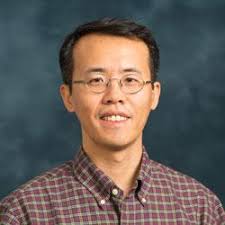
Driving behavior caused by vehicle interactions, such as acceleration, deceleration, and stop-and-go, is highly associated with traffic safety and the environment. The purpose of this study is to investigate whether traffic safety can be linked to environmental conditions, more specifically crash potential and on-road vehicle emissions. Individual vehicle trajectory data obtained from the US-101 freeway, as a part of the Next Generation Simulation (NGSIM) project, was used to investigate the relationship. A probabilistic rear-end crash potential model and a motor vehicle emission simulator (MOVES) were adopted to characterize traffic safety and environmental conditions, respectively. Both the crash potential index (CPI) and the vehicle emission index (VEI) were derived, and then investigated through correlation, regression, and clustering analyses. The findings revealed that the relationship is positively correlated and statistically significant. In addition, the results showed that severely congested traffic conditions, which include frequent stop-and-go situations and the formation of shockwaves, lead to greater crash potential as well as vehicle emissions. In summary, traffic safety and environmental conditions are positively associated. The outcomes of this study are expected to be used as useful fundamentals in developing effective vehicle safety and emission control programs and policies.
Cheol Oh received the Ph.D. degree in civil engineering-transportation from the University of California, Irvine. He is currently an Associate Professor with the Department of Transportation and Logistics Engineering, Hanyang University at Ansan, Korea. His research interests include traffic operations and control, traffic safety, and intelligent transportation systems (ITS). He is primarily focused on the development and application of information technologies toward safer and more efficient transportation systems. He has authored 94 peer-reviewed journal papers (Korean:66, International:28).Network and Spatial Economics. He is also on the editorial board of Transportation Research Part B, Journal of Intelligent Transportation Systems, and IET Intelligent Transportation Systems Journal.

Understanding the traffic evolution process after an unexpected network disruption is of great significance to traffic engineers who are responsible for traffic restoration. In this talk, we will discuss our recent findings on the day-to-day traffic equilibration process following the unexpected collapse and eventual reopening of the I-35W Bridge over the Mississippi River in Minneapolis. Following the I-35W Bridge collapse, drivers were observed to drastically avoid areas near the disruption site until the perceived congestion in that area gradually diminished. After the reopening of the disrupted link, despite a complete restoration of network topology, it was found that total demand restoration on that link did not occur, implying that a different traffic equilibrium was reached. Due to the rare occurrence of the network disruption event, such behaviour has not been reported in the literature and none of the existing day-to-day traffic assignment models are capable of explaining the empirical evidences. To fill in this gap, we have developed a nonlinear dynamic system that is capable of describing the transient states of a disrupted network, answering questions related to the traffic evolution trajectory from a disequilibrium (due to a network disruption) toward an equilibrium. Our models are calibrated and validated using the data collected from the Twin Cities network after the bridge collapse and reopening. To the best of our knowledge, this is the first time that day-to-day traffic equilibration models have been constructed and compared against real world observations.
Dr. Henry Liu is currently an associate professor of Civil Engineering at the University of Minnesota – Twin Cities. Before joining the University of Minnesota, he was an assistant professor at Utah State University and a post-doctoral researcher at the California PATH Program of UC-Berkeley. He received his Ph.D. degree in Civil and Environmental Engineering from the University of Wisconsin at Madison in 2000 and his B.E. degree in Automotive Engineering from Tsinghua University (China) in 1993. Dr. Liu’s research interests are in the area of traffic network monitoring, modeling, and control, which includes traffic flow modeling and simulation, traffic signal operations, and equilibrium traffic assignment. On these topics, he has published more than 50 articles in peer-reviewed journals. Dr. Liu is currently the overview paper editor of Transportation Research Part C and an associate editor of Network and Spatial Economics. He is also on the editorial board of Transportation Research Part B, Journal of Intelligent Transportation Systems, and IET Intelligent Transportation Systems Journal.

This talk describes a new framework for solving control and estimation problems in systems modeled by scalar conservation laws with convex flux, with applications to highway traffic flow estimation and control. Using an equivalent Hamilton-Jacobi formulation, we show that the solution to the original PDE can be written semi-analytically. Using the properties of the solutions to HJ PDEs, we prove that when the data of the problem is prescribed in piecewise affine form, the constraints of the model are mixed integer linear. This property enables us to identify a class of transportation engineering problems (control, estimation, fault detection, user privacy analysis) that can be solved exactly using MILPs.
Christian Claudel is an assistant professor of Electrical Engineering and Mechanical engineering at KAUST. He received the PhD degree in EECS from UC Berkeley in 2010, and the Ms degree in Plasma Physics from Ecole Normale Superieure de Lyon in 2004. He received the Leon Chua Award from UC Berkeley in 2010 for his work on Mobile Millennium. His research interests include control and estimation of distributed parameter systems, wireless sensor networks and environmental sensing systems.

Although a normative approach was developed to address the issue of capturing spatial-temporal constraints in a utility maximization framework for activity-based modeling, two key issues linger. The first is a need for a parameter estimation approach for each household’s set of parameters given multiple objectives such that observed arrival times and sequences can both be replicated. An approach was recently proposed and tested using an inverse optimization method. It has been partially applied to calibrate truck activity patterns. The second key issue is overcoming the complexity of the underlying NP-hard problem, particularly to apply the model to analyze different scenarios with numerous repeated runs. The concept of reoptimization — altering a prior instance solution — has been shown by researchers to generally be NP-hard as well, but proven that reoptimization heuristics result in tighter worst-case bounds. Two reoptimization heuristics are proposed for a selective extension of the HAPP model (which cannot be solved without heuristics) and tested in a computational experiment involving 100 zones and 500 simulated households. Results suggest that reoptimization algorithms are effective for selective vehicle routing problems, and solutions appear to be within tighter bounds than using a genetic algorithm without prior instance information. These new developments encourage further research to incorporate normative routing models to address routing/scheduling choices in existing activity-based models.
Dr. Chow obtained his Ph.D. at UC Irvine in 2010 under Dr. Amelia Regan. He has been a postdoc at UCI from 2010-2012, working
with Dr. Stephen Ritchie on freight forecast modeling and with Dr. Will Recker on the household activity pattern problem. Dr. Chow
will be leaving UCI on May 29th and starting as an Assistant Professor at Ryerson University in Toronto, Canada, on June 1st.

This presentation talks about a series of recent applications using high-resolution vehicle-detector actuation and signal phase change event data. High-resolution event data provides detailed detector occupied times and time gaps between two consecutive vehicles. Such information is of great importance to help understand traffic and driving behaviors under congested conditions. High-resolution data are first used to investigate queuing dynamics at congested signalized intersections. A model, combined with the Lighthill-Whitham-Richards (LWR) theory, is developed to estimate intersection queue length under congested situation, a situation in which the traditional input-output method cannot work. This research then investigates the arterial fundamental diagram (AFD), in which the highly scattered cloud is lack of explanations so far. Using high-resolution data, we found that the scatter in the AFD is mainly caused by signal operations instead of traffic congestion. The final part of the talk presents an investigation of driving behaviors using a whole year’s high-resolution data. A model is developed to describe the stochasticity of drivers’ gap selection. This model is also used to investigate the potential impact on the fundamental diagram caused by the stochasticity of drivers’ gap selection.
Dr. Xinkai Wu is an Assistant Professor of Civil Engineering at California State Polytechnic University Pomona. His research interests include urban traffic operations, network traffic flow modeling and simulation, driving behavior study, and applications of Intelligent Transportation Systems (ITS). Dr. Wu graduated from the University of Minnesota with a Ph.D. in Civil Engineering in 2010. He is the co-inventor of a pending patent: SMART-SIGNAL (Systematic Monitoring of Arterial Road Traffic Signals) technology, which collects and archives real-time high-resolution event data on signalized arterials.

This presentation will describe ongoing research to analyze the impacts of extreme weather (and other) events on transportation systems and to develop decision support tools for system operators. The Desert Road in New Zealand, prone to snowy and icy conditions, volcanic eruptions, lahars, and seismic events, will be used as a case study. The recent Christchurch earthquakes and their impact on transport will also be discussed. The presentation will also examine opportunities for providing decision support to pilots, airlines, and air traffic controllers during periods of convective weather. One of the themes of the presentation will be the motivation for, as well as the setup and solution of, multicriteria transportation system management problems. Often overlooked objectives of such a problem include minimizing risk, inequity, and environmental impacts. There will also be some discussion of the importance of simulation for managing road networks during extreme weather events and the danger of taking simulation results at face value, particularly in aviation systems research.
Kenneth Kuhn is a Lecturer in the Department of Civil and Natural Resources Engineering at the University of Canterbury in Christchurch, New Zealand. His research interests include infrastructure management, logistics and supply chain management, and aviation systems. Prior to moving to New Zealand, Kenneth worked for two years for the National Aeronautics and Space Administration in California. He graduated from UC Berkeley with a Ph.D. in Civil Engineering in 2006, having written a dissertation
under the supervision of Professor Samer Madanat.

The continuously increasing daily traffic congestions on motorway networks around the world call for innovative control measures that would drastically improve the current traffic conditions. Mainstream traffic flow control (MTFC) is proposed as a novel and efficient motorway traffic management tool, and its possible implementation and principal impact on traffic flow efficiency is analysed. Variable speed limits, suitably operated and enforced, is considered as one (out of several possible) way(s) for MTFC realisation, either as a stand-alone measure or in combination with ramp metering. A previously developed, computationally efficient software tool for optimal integrated motorway network traffic control including MTFC is applied to a largescale motorway ring-road. It is demonstrated via several investigated control scenarios that traffic flow can be substantially improved via MTFC with or without integration with coordinated ramp metering actions.
Markos Papageorgiou received the Diplom-Ingenieur and Doktor-Ingenieur (honors) degrees in Electrical Engineering from the Technical University of Munich, Germany, in 1976 and 1981, respectively. He was a Free Associate with Dorsch Consult, Munich (1982-1988), and with Institute National de Recherche sur les Transports et leur Sécurité (INRETS), Arcueil, France (1986-1988). From 1988 to 1994 he was a Professor of Automation at the Technical University of Munich. Since 1994 he has been a Professor at the Technical University of Crete, Chania, Greece. He was a Visiting Professor at the Politecnico di Milano, Italy (1982), at the Ecole Nationale des Ponts et Chaussées, Paris (1985-1987), and at MIT, Cambridge (1997, 2000); and a Visiting Scholar at the University of California, Berkeley (1993, 1997, 2001, 2011) and other universities.

We apply a fixed-effects model to examine the impact of trade and environmental policies on air quality at ports along the U.S. Mexico border. We control for other factors influencing air quality, such as air quality of cities near the border, volume of traffic flows and congestion. Results show the air quality improved after 2004, when the diesel engine policy was applied. We see mixed results for the trade policy, whose implementation time varies across ports along the international border. Controlling for air quality in cities near the border is essential for assessing the policy contributions to air quality.
Linda Fernandez has been associate professor of environmental and resource economics at UC Riverside since 2005. She received her PhD from UC Berkeley’s Dept. of Agricultural and Resource Economics. Her research explores public and private economic incentives for pollution control and natural resource protection through empirical applications of economic theory. Her research can be divided into three major categories: 1) transboundary environmental problems; 2) biodiversity; 3) air and water quality regulations.

A simulation-based pilot study is performed to evaluate the socio-economic effect of seismic retrofit of bridges using Caltrans’ Los Angeles area highway network as testbed. 47 scenario earthquakes that represent the regional seismic hazard, consistent with the USGS hazard data are used for this purpose.Two sets of bridge fragility curves, for before and after seismic retrofit, are developed and used to simulate the seismic performance of the network in both cases. The analysis estimates the total societal cost arising from drivers’ delay and loss of opportunity cost in the damaged network. The benefit of seismic retrofit is computed as present values of the total future economic loss avoided both from societal cost and from repair/restoration cost over the remaining bridge service lives. Estimated benefit is compared with the retrofit cost to establish the
benefit-cost ratio. Study shows that from Caltrans’ point of view bridge seismic retrofit is cost-effective when loss avoided due to societal cost is considered.
Dr. Shinozuka is a world-renowned expert in earthquake and structural engineering. He is especially interested in field theory and risk assessment methodology in civil engineering.
Dr. Shinozuka’s research focuses on continuum mechanics, micromechanics, stochastic processes and fields, structural dynamics and control, and earthquake and wind engineering. He also studies systems engineering, with an emphasis on structural and system reliability; risk assessment of lifeline systems, including water, electrical power and transportation networks; and analysis of the socio-economic impacts of natural disasters. He also is interested in advanced technologies, specifically remote sensing and geographic information systems (GIS) for disaster assessment and mitigation, smart materials and structures, and nondestructive evaluation.
The applications for his work are in earthquake engineering in buildings, bridges, lifelineand environmental systems. His workhighlights the multidisciplinary aspects of infrastructure system problems.
Dr. Shinozuka is a member of the National Academy of Engineering.

Paratransit services often adopt decentralized zoning strategies to divide large service area into smaller zones assigned to different providers in order to simplify their management. If zones are independently managed, there is no coordination among providers. This causes the overall system to be quite inefficient, due to a large
amount of empty trip miles driven, a major cause for these services’ high operating costs. Coordination among providers is possible by including transfer points at zone boundaries and can potentially improve productivity. The zoning with transfer practice has been adopted by some transit agencies (Chicago, Boston and San Diego,
for example) but never properly investigated from a research point of view. This research study evaluates the impact of transfer design on decentralized zoning paratransit through extensive simulation analyses and related sensitivity analyses to evaluate the interaction among geographic boundaries, size of service area, demand distribution and number of transfer points.
Dr. Luca Quadrifoglio graduated with the Laurea in Chemical Engineering (1996) from the Giulio Natta Department of Chemistry, Materials & Chemical Engineering at the Politecnico of Milan (Italy). He worked as a Process Engineer and Project Economist for Snamprogetti (ENI Group) in Milan for five years, being primarily responsible for developing large-scale techno-economic feasibility studies as a decision support tool for the firm’s executives. He received his M.S. in Engineering Management (2002) and Ph.D. (2005) degrees from the Daniel J. Epstein Department of Industrial and Systems Engineering at the University of Southern California in Los Angeles, California. Then he worked as a Postdoctoral Research Associate at the USC’s Department of Homeland Security Center for Risk and Economic Analysis of Terrorism Events (CREATE) until August 2006, when he joined the Faculty of the Zachry Department of Civil Engineering at Texas A&M University in College Station, Texas. Dr. Quadrifoglio published a number of papers in top rated Journals, won the 2006 Pritsker Doctoral Dissertation Award (3rd place) and the 2004 Council of University Transportation Center (CUTC) National Student Award for best publication in Science and Technology.
His research interests are related to the broad field of Operations Research applied to a variety of fields, primarily Transportation/Logistics, and include Transportation Systems Modeling and Design, Network Optimization, Math Programming, Simulation, Scheduling Algorithms (Vehicle Routing, Pickup and Delivery), Innovative Transit/Logistics Solutions, Performance/Risk/Decision Analysis.


